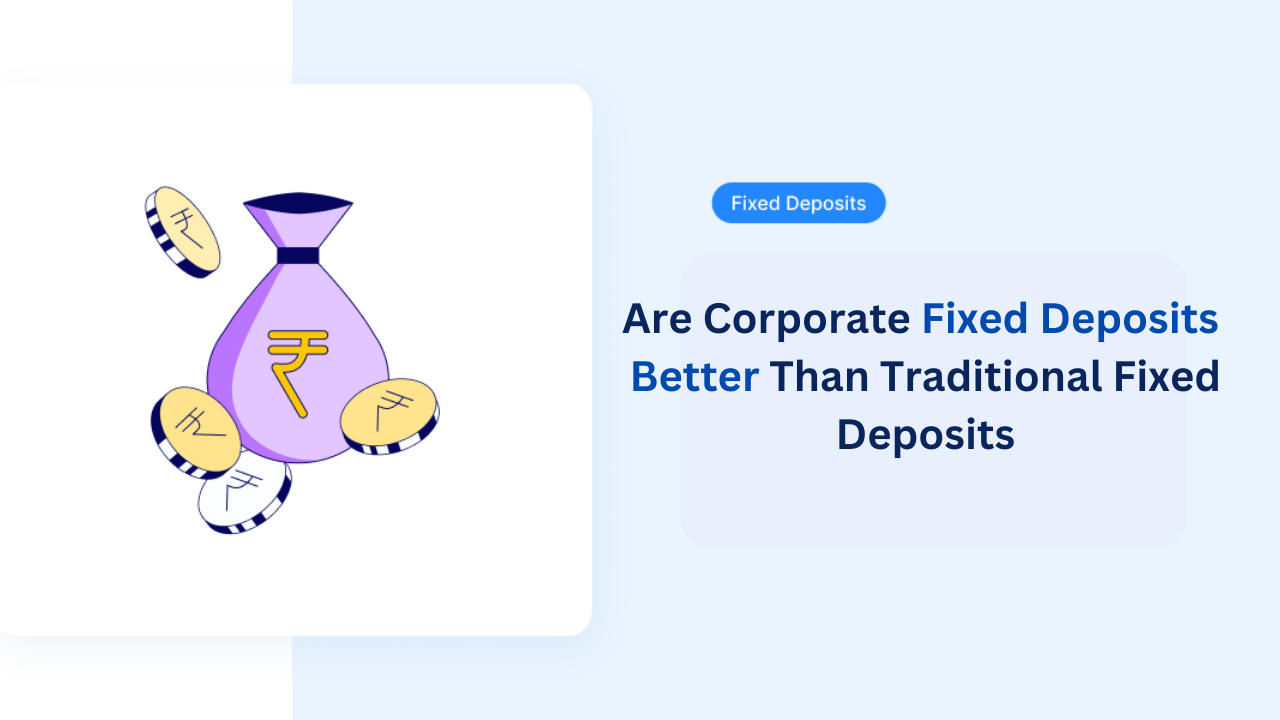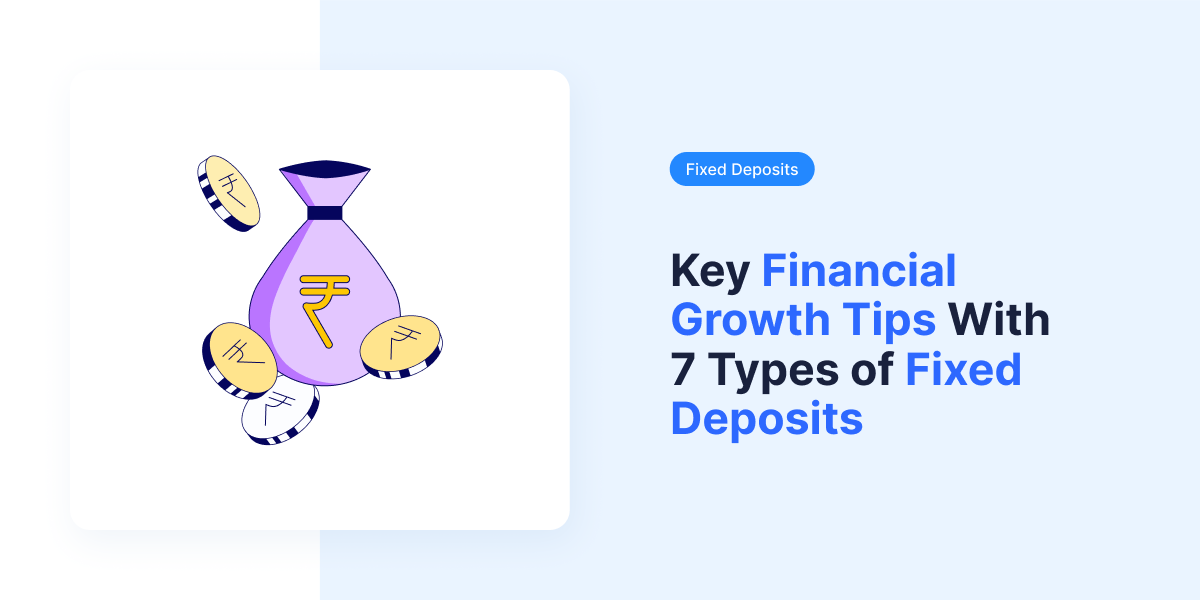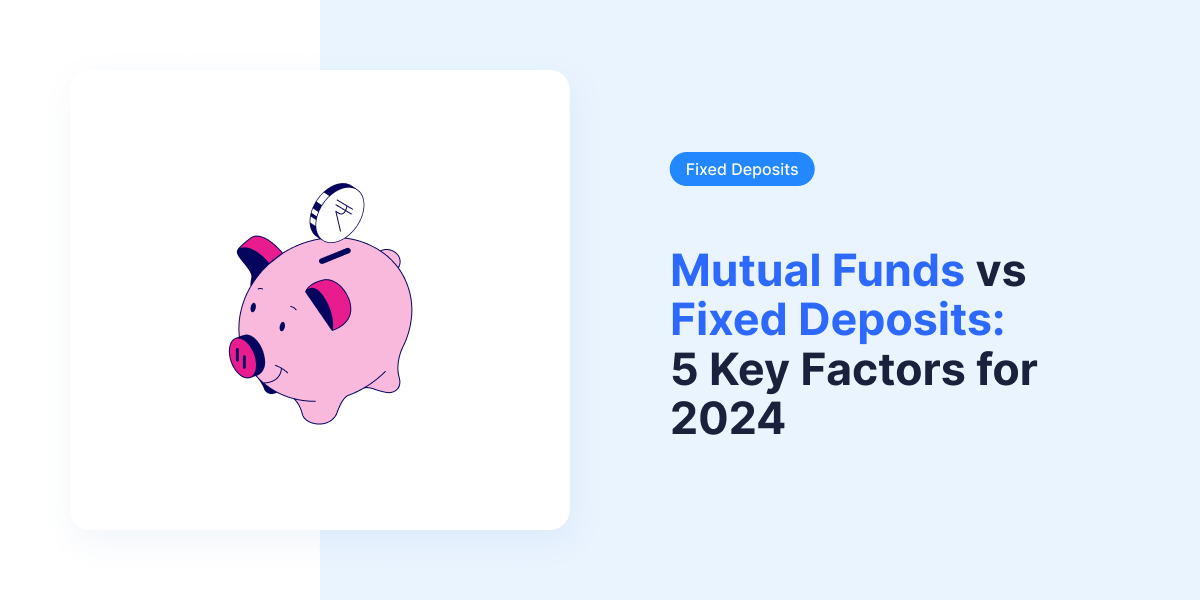All About Child Education Investment Plans in 2024
What are child education investment plans?
What is the best investment plan for your child’s education? When should you start investing for your children? Let’s explore all the facts in this blog.
A child education investment plan is a plan to systematically invest for your child’s higher education. The costs of education are skyrocketing. A recent twitter post by a father in Delhi showed how the playschool fees for his son’s one year of schooling was nearly ₹4,30,000! Inflation in the education sector is nearly 10-11%. More than the average retail inflation in our country. From school to college fees to living expenses related to education are increasing faster than our average salaries. Thus, the need for a child education investment plan that can help parents tackle this cost is tremendous. A child education investment plan includes a series of investments that you can consider in order to save for your child’s education. These investment options and plans can help you easily save for your child’s college and school fees. Without compromising your current savings or limiting your expenses, you can start investing in these plans with a minimal cost and eventually increase your investments as your child grows and your salary maximizes. Let’s look at some child education investment plans and the various investments within its gambit.
Best Investment Plan for Child Education in India in 2024
What is the best investment plan for child education? What asset should you choose for your child’s higher education savings? Which asset can help you keep up with the growing education costs in India? The answer is simple and highly convenient – it is Mutual Funds.
Mutual Fund is the best investment asset for saving for higher education. Mutual funds have historically given returns of 10-12% over a long horizon. Successfully keeping pace with education inflation rate which is at 10%. Mutual funds are affordable, you can start investing with just ₹100 monthly and increase your investments systematically.
The greatest benefit of Mutual funds is that they are managed by professional fund managers. At minimal cost, you have experts watching your portfolio and making the necessary adjustments to ensure your money grows at the intended pace. Mutual funds’ transparency over costs and its investment strategies is another major benefit. Here are some mutual funds that you can consider you are planning to invest for child education and their college needs.
Sr. No. Scheme Name Category Sub-Category Inception Date AUM Expense Ratio 1Y Return 3Y Return 5Y Return 1. Nippon India Small Cap Fund Equity Small Cap 1/1/2013 43,816 0.67% 59.3% 42.60% 31.57% 2. HDFC Mid-Cap Opportunities Fund Equity Mid Cap 1/1/2013 56,033 0.80% 53.99% 33.89% 25.41% 3. SBI Contra Fund Equity Contra 1/1/2013 21,482 0.69% 45.69% 33.46% 26.70% 4. HDFC Balanced Advantage Fund Hybrid Dynamic Asset Allocation 1/1/2013 73,349 0.80% 38.43% 27.55% 19.72% 5. DSP Nifty 50 Equal Weight Index Fund Equity Index (Large) 10/27/2017 1,004 0.40% 33.31% 23.64% 18.89%
Note: All are Direct plan and growth option; AUM and Expense ratios are as on December 31, 2023; 3Y/5Y returns are annualized and as on January 30, 2024. Source: Value Research
Note: Mutual fund investments are subject to market risk, please read all scheme related documents before investing. Past performance is not indicative of future results. This is not an investment recommendation.
Fund Details
Fund Details
Nippon India Small Cap Fund:
This fund is being managed by Mr. Samir Rachh (Since January 2017) and Mr. Tejas Sheth (Since February 2023) who is an assistant fund manager.
The fund has provided 27.07% of return since inception and it has outperformed the category over the last 1/3/5/7/10 years.
It has delivered the highest returns in the category over the last 7 and 10 years and has been in the top 3 over the 3 and 5-year period.
The fund has delivered the best risk-adjusted returns over the last three years, depicted by the highest Sharpe ratio.
HDFC Mid Cap Opportunities Fund:
This fund is being managed by Mr. Chirag Setalvad who has been the head of equities since June 25, 2007, and Mr. Dhruv Muchhal who is an Equity Analyst and Fund manager for Overseas investment.
HDFC Mid Cap Opportunities Fund is the largest fund in the mid-cap space with an AUM of Rs. 56,033 crores and is the only fund in the category to have an AUM of more than Rs. 50,000 crores.
The fund has provided a 21.76% return since inception and has outperformed its category and the mid-cap index in all the time horizons of 1/3/5/7/10 years.
The fund has delivered better returns per unit of risk depicted by the lower standard deviation and the beta compared with the category average.
SBI Contra Fund:
The fund has been in existence for approximately 25 years and has been managed by Mr. Dinesh Balachandran since May 2018 who has 17 years of rich experience in this field.
This fund has provided a whooping return of 19.59% since its inception date and has outperformed its benchmark S&P BSE 500 TRI in all the time horizon.
The fund follows a contrarian strategy while investing in equity and provides exposure to companies of all sizes.
The fund has delivered the best risk-adjusted returns in the category, as depicted by the highest Mean Return, Sharpe Ratio, Sortino Ratio and Alpha.
HDFC Balanced Advantage Fund:
HDFC Balanced Advantage Fund is one of the oldest funds in India and is the largest fund in the balanced advantage category, with an AUM of Rs. 73,349 crores.
The fund has been the top performer in the category for over 1/3/5 years and has delivered an impressive return of 16.04% since inception.
Although the fund has been volatile more than the category, it has delivered a significantly higher alpha of 10.34% compared to the category average of 1.35% over three years.
This fund has been managed by Mr. Srinivasan Ramamurthy, Mr. Gopal Agarwal, Mr. Anil Bamboli, Mr. Arun Agarwal, and Mr. Nirman Morakhia.
DSP Nifty 50 Equal Weight Index Fund:
This fund is being managed by Mr. Anil Ghelani (since July 2019) and Mr. Dipesh Shah (since November 2020).
This fund tracks the Nifty 50 Equal Weight TRI, allowing us to have exposure to large-cap equities where the probability for alpha generation is very low.
Compared with Nifty 50 TRI, Nifty 50 Equal Weight Index TRI has delivered better returns with lower volatility over a long-term period from June 2000 to April 2023.
The fund delivered an alpha of 3.75% whereas the other funds in the category struggled to outperform the benchmark over the last three years.
Important Note: These mutual funds are not our recommendations. Please consult your financial advisor before investing money in mutual funds.
Benefits of Child Education Investment Plan
The cost of education is rising rapidly, making it crucial to plan and invest early for your child's future. Tuition and fees increased more than 2,200% from 1970 to 2020. Meanwhile, inflation was around 600%. Here are 7 benefits of child education investment plan:
Beat Inflation: Education costs are outpacing inflation. By starting early, you allow your investments to grow and counter the rising costs of universities, colleges, or specialized programs.
Peace of Mind: Knowing you have a dedicated fund for your child's education reduces financial stress and allows you to focus on other aspects of their upbringing.
Power of Compounding: Starting early allows you to leverage the power of compound interest. Even small regular investments can grow significantly over time, thanks to interest earned on interest.
Flexibility: Many child education plans offer flexible payout options. The corpus can be used for various education-related expenses, including tuition fees, accommodation, or study materials.
Discipline & Habit Building: Regular contributions inculcate financial discipline in you and teach your child the value of saving for long-term goals.
Freedom of Choice: A well-funded education plan empowers your child to pursue their desired educational path without limitations due to financial constraints. This could mean attending a dream university, pursuing a specific program abroad, or taking on internships without financial worries.
Secures Your Child's Future: Investing in your child's education is an investment in their future. A good education opens doors to better career opportunities, financial stability, and a brighter future.
Best Investment Options for Child Education
Best Investment Options for Child Education
Let’s look at some of the best investment options for child education available to parents in 2024.
Education Savings Plan
Education savings plans are investment plans that allow you to save for your child’s education costs. Some plans are incentivized and may offer tax benefits such as Sukanya Samriddhi Yojana in India offers tax exemptions under section 80C of the Income Tax Act of 1961. Some are extremely affordable with minimal investments starting at ₹100 or 1000. Let’s cover some education savings plan that you can utilize. Sukanya Samriddhi Yojana It is a unique child investment plan for parents of a girl child. This is offered by the Indian government to encourage parents to save and invest in their daughters early on. The main objective of the SSY program is to encourage parents to make substantial financial commitments to a strategy for their daughters’ future education and marriage.
Parents who have girls under the age of ten can invest in the SSY program. The SSY program investment is locked in for 21 years post-account opening. Investments made in SSY accounts are eligible for tax deductions under Section 80C of the Income Tax Act of 1961. Each year, a minimum investment of ₹250 must be made, and a maximum investment of ₹1,50,000 may be made. SSY accounts can be opened and utilized at any location of an accredited bank or the India Post Office.
529 Plans
529 plans are a powerful tool for US residents to save for a child's future education. 529 plans are tax-advantaged investment accounts. They are designed specifically to encourage saving for education expenses.
The beauty of 529 Plans is that contributions to a 529 plan grow tax-free federally. This means all earnings on your investments compound without being reduced by taxes, maximizing your potential returns. Similarly, withdrawals from a 529 plan are completely tax-free at the federal level if the earnings are used for qualified education expenses. Some states also offer additional state tax benefits.
Contributions to a 529 plan can be made by anyone, not just the account owner. This allows grandparents, relatives, or friends to contribute towards a child's education. This plan is not available for Indian citizens and only open for American citizens.
Coverdell ESAs
Coverdell ESAs are another tax-advantaged investment account option in the US for saving towards a child's education. The contributions are not tax-deductible federally, but earnings within the account grow tax-free if used for qualified education expenses. The annual contribution limit for a Coverdell ESA is capped at $2,000 per beneficiary per year.
Coverdell ESA funds can be used for a wider range of qualified K-12 expenses like tuition, fees, tutoring, and even some educational materials. You can open a single Coverdell ESA for multiple beneficiaries if they meet the eligibility criteria.
This investment option is not for Indian citizens. Tax benefits and withdrawal rules Tax benefits as well as withdrawal rules depend on the type of education savings plans you have chosen.
Some plans offer tax deductions for contributions, reducing your taxable income.
Investment earnings within the plan typically grow tax-free.
In the case of 529 Plans and Coverdell ESA, withdrawals used for education expenses are usually tax-free. Under Sukanya Samriddhi Yojana Scheme, the girl child can make an early withdrawal of up to 50% of the balance in the account at the age of 18 years before the maximum maturity tenure of 21 years. However, this amount can only be withdrawn for her higher studies or marriage.
Important Note: It's crucial to research the specific plan you're considering understanding its contribution limits, investment options, tax implications, and withdrawal rules.
Mutual Funds
As mentioned earlier, mutual funds are a game-changer. They are the best investment asset in India to save for your child’s education needs. The ease of investing in mutual funds, transparency, affordability as well as the tax benefits may them an amazing investment tool for your long-term goals such as your child’s college savings.
When saving for your child's education through mutual funds, you need to consider the investment horizon (timeframe until the funds are needed) and your risk tolerance. Here's a breakdown of suitable mutual funds and how they differ:
Types of Mutual Funds for Education Savings:
Equity Mutual Funds: Invest primarily in company stocks. They offer the potential for higher long-term returns but come with higher risk due to market fluctuations. Suitable for: Long-term investment horizons (10+ years). Investors who are comfortable with market volatility. Within Equity Mutual Funds, you have a special fund category called ELSS (Equity Linked Saving Scheme). They tax deductions under Section 80C of the Income Tax Act, 1961 and have a lock-in period of 3 years.
Debt Mutual Funds: Invest in fixed-income securities like bonds and government securities. They offer lower risk and predictable returns, but growth potential is limited. Suitable for: Shorter investment horizons (5-10 years). Risk-averse investors seeking capital preservation.
Balanced Funds: A mix of equity and debt funds, offering a balance between risk and return. They can be a good middle ground, but returns may be lower than pure equity funds. Suitable for: Moderate investment horizons (7-12 years). Investors seeking a balance between growth and stability.
Equity vs Debt Mutual Funds: What’s Better?
Category Equity Mutual Funds Debt Mutual Funds Investment Type Company Stocks Fixed Income Securities Risk High Risk Low Risk Expected Returns Higher in the long run Lower as compared to Equity Management Costs Lower Higher Investment Horizon Suitable for long term goals Suitable for long & short-term goals
Mutual Funds via SIPs (Systematic Investment Plan) A Systematic Investment Plan (SIP) allows you to invest a fixed amount in a mutual fund at regular intervals (monthly, quarterly, etc.). SIPs allow you to invest in the long run without breaking the bank. SIPs offer several benefits for education savings:
Rupee-Cost Averaging: Invests a fixed amount regardless of the market value, potentially buying more units when the price is low and fewer units when the price is high, averaging out the cost per unit over time.
Discipline and Habit Building: Encourages regular saving and instills financial discipline.
Compounding: Allows returns to be reinvested, leading to faster growth over time.
Flexibility: You can start with a small amount and gradually increase it as your income grows.
Convenience: Automates the investment process, making it easier to stay on track with your savings goals.
Fixed Deposits and Savings Account Fixed deposits and savings accounts are traditional savings options, but how do they stack up for child education savings? Here's a detailed breakdown:
Child-Specific Fixed Deposits
Child-specified fixed deposits offered by some banks; these FDs cater specifically to children. For instance, Punjab National Bank offers the PNB Balika Shiksha Scheme for girls enrolled in government schools. The interest rates for fixed deposits for children are similar to regular FDs. There is a lock in your investment for a fixed term (typically ranging from 1 to 10 years). In case of early withdrawal, penalties may incur.
The biggest advantage is the returns are guaranteed by the bank, making them a safe investment option. These investments provide a sense of security knowing the principal amount is protected. These fixed deposits are ideal for education needs within 5 years where principal preservation is of utmost importance.
The drawbacks are that the interest rates on FDs are generally lower than inflation, resulting in potential loss of purchasing power over time. There are other instrument options that offer better returns. The locked-in period for a fixed term limits access to funds before maturity.
Savings Accounts
Savings accounts are another investment option for parents to save funds for their children. The interest rates are generally between 3 to 4%, there is no lock-in period, some banks require you to maintain minimal funds for operating the account otherwise there may be a penalty. These savings accounts have no risk involved and your child’s savings are protected till they decide to withdraw them. There is no maximum investment; you can invest based on your needs.
Savings accounts can be opened on behalf of the minor, that is your child, and the guardian can operate the account on the behalf of the child.
Interest Rates and Tax Implications
Interest Rates: FD interest rates vary depending on the bank, chosen term length, and prevailing market conditions.
Tax Implications: Interest earned on FDs is generally taxable as per income tax slabs. However, some tax benefits may be available for specific FD schemes. It's important to consult with a tax advisor about the latest regulations.
Stocks and Bonds Stocks and bonds are fundamental investment tools that can be utilized for your child's education savings plan. Let's explore them in detail:
Stocks
Investing in stocks on your child’s behalf is also a good option. Stocks can potentially beat inflation and are a great source of investment for long-term goals such as college fees. Individual stocks offer the possibility of significant returns over extended periods (10+ years). Owning shares in well-performing companies can significantly grow your capital.
Do not that the stock market is inherently volatile. Individual stock prices can fluctuate significantly, leading to potential losses. A single stock option can be expensive or affordable depending on the company. The price can range from ₹10 to ₹1,00,000. Selecting individual stocks requires in-depth research on company financials, industry trends, and market conditions. Understanding the risks involved is crucial.
Importance of Diversification
Diversification is the key to a good child education investment plan. Every investment advisor would tell you to never put all your eggs in one basket! Diversification helps in minimizing risk. It allows you to spread your investments across various companies and sectors to avoid being overly reliant on the performance of a single stock.
Bonds
Bonds are issued by governments and corporations when they want to raise money. It is a debt security and a safer investment option than stocks. Bond returns are generally lower than stocks, especially over the long term. Bonds provide predictable income streams, making them suitable for investors seeking stability and capital preservation.
Insurance Plans
In India, there are different kinds of insurance plans to protect your child’s future. Insurance plans are a good backup plan that gives you peace of mind.
Child Education Insurance Policies
A child education insurance plan is designed for parents to secure their child's future education. Parents have to pay a certain amount of premium and they will receive a certain maturity benefit for the child's higher education.
In case of the unfortunate passing away of the policyholder (parent), the insurance company provides a lump sum payout. This financial cushion ensures the child's education expenses can still be met. The investment horizon is typically 15-25 years. Upon maturity, the policy pays out a lump sum amount that can be used for the child's education. Some plans may also offer regular payouts to help manage education expenses throughout the child's education journey.
Benefits of Combining Insurance and Investment:
Peace of Mind: Provides financial security for the child's education even in unforeseen circumstances.
Disciplined Saving: Regular premium payments instill financial discipline and help accumulate funds over time.
Potential Tax Benefits: Premiums paid towards child education plans may be eligible for tax deductions under Section 80C of the Income Tax Act (subject to change).
Key Features to Look for in a Child Education Insurance Plan
Sum Assured: This is the guaranteed death benefit paid by the insurer in case of the policyholder's demise. Choose an amount that would adequately cover future education costs.
Maturity Benefit: Consider the future education costs and choose a plan that offers a sufficient payout to cover them.
Premium Payment Term: Select a premium payment term that aligns with your financial situation. Some plans offer flexible payment options.
Claim Settlement Ratio: Research the insurance company's claim settlement ratio to understand their track record of honoring claims.
Policy Riders: Consider adding optional riders like waiver of premium rider, which ensures premium payments are waived if the policyholder becomes disabled.
Gold and Real Estate
Gold and real estate investing are some of the oldest and most beloved ways to invest for your child’s education in India. Let’s see why these are a great addition to the child education investment plan.
Investing in gold as a hedge against inflation
Gold is often perceived as a natural hedge against inflation. Its price has shown some tendency to rise alongside inflation. Gold can be relatively easy to buy and sell. Gold is a highly liquid asset; you can even use gold for taking on loans to meet your immediate financial needs. Various investment options exist, including physical gold, gold ETFs, and digital gold.
Like any investment, gold prices can be volatile in the short term. Consider a long-term investment horizon to benefit from potential price appreciation.
Real estate investments for long-term gains
Real estate is a great way to invest for your long-term goals. Real estate can offer significant capital appreciation over the long term, especially in growing locations. Additionally, rental income can provide a steady income stream. You can use your properties are collateral for taking different kinds of loans which makes it a good asset for rainy times.
However, investing in real estate is not easy. Real estate requires a significant upfront investment, which might not be feasible for everyone. Real estate is a relatively illiquid asset. Selling property can take time and involve additional costs.
Risks and returns associated with these investments
Gold and real estate are not typically high-risk investments. Historically, both investments have shown appreciation over the long-term horizon. Both investments do require high capital for your investment to appreciate at the same pace as inflation. They both act as a hedge for inflation.
Both gold and real estate come with their own set of risks and require research before investing. Consider your financial situation, investment goals, and risk tolerance when deciding if these options are suitable for your child's education savings plan.
Need help investing for your child’s education needs? Connect with our experts to get a personalized child education investment plan to secure your child’s future today!














